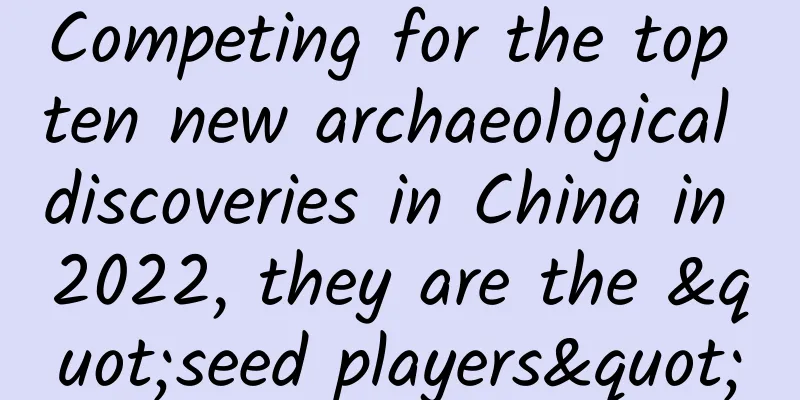Competing for the top ten new archaeological discoveries in China in 2022, they are the "seed players"

|
Chinese civilization has a history of origin of more than 8,000 years and a history of formation of more than 5,000 years. It is precisely the new archaeological discoveries that have extended the historical axis of Chinese civilization, continuously enhanced historical credibility, enriched historical connotations, and made historical scenes more vivid. The top ten archaeological discoveries in China in 2022 are expected to be announced at the end of this month. Previously, the preliminary evaluation results have been announced: a total of 22 projects have entered the final evaluation stage (see the end of the article for details). The bronze chariot at the Zhouyuan site is known as the "first luxury chariot in the Western Zhou Dynasty" As in the past, most of the shortlisted projects were suspenseful. For example, the Zhouyuan Site in Baoji, Shaanxi, which attracted much attention in 2021, ultimately failed to win in the fierce competition. However, every year, there are at least two or three outstanding archaeological discoveries on the candidate list, which are considered "seed players" with little suspense in the eyes of archaeological experts. For example, the Sanxingdui Ruins was selected as one of the top ten archaeological discoveries in China in 2021. Similarly, among the top ten archaeological discoveries in the country in 2022, there are several projects that some archaeological experts believe will be selected without a doubt. Xuetangliangzi Site What did "Yunxian people" mean a million years ago? Xuetangliangzi Site is located in Yunyang District, Shiyan City, Hubei Province. It is a large wilderness site from the early Paleolithic period. In 1989 and 1990, two ancient human skull fossils were unearthed at the site, dating back to about 1.1 million to 800,000 years ago. They belonged to Homo erectus and were named "Yunxian Man" by the academic community. Every skull fossil from ancient times is extremely precious. Human bones are difficult to preserve, and the older they are, the harder it is to find them - groundwater erosion, acid and bacteria in the soil... can easily turn bones to dust. On May 18, 2022, the third "Yunxian Man" skull was discovered at the Xuetangliangzi site. It has been 33 years since the first skull was discovered. Compared with the previous two, the newly discovered skull No. 3 is well preserved, has a clear shape, and has no obvious deformation. The characteristic information it can provide is richer and more real than the two previously discovered skulls, and is therefore more precious. Newly discovered Yunxian Man No. 3 skull The ecstatic archaeologists said that this skull is "the best-preserved ancient human skull fossil of the same period found in inland Eurasia so far." It took the archaeologists more than half a year just to dig it out of the ground, and they did their best to preserve it intact, and even built a cabin with constant temperature and humidity on site. The Yunxian Man No. 3 skull was tightly wrapped when it was unearthed. The owner of this skull lived on Earth about 1 million years ago. He/she is not even the direct ancestor of modern humans, but the more ancient Homo erectus. The ancestor of modern humans is Homo sapiens. There are currently two different hypotheses about the origin of Homo sapiens. One school of thought believes that about 300,000 years ago, early Homo sapiens evolved in Africa. About 60,000 years ago, some of these Homo sapiens walked out of Africa and spread around the world. In the process, Homo sapiens gradually "killed" Neanderthals, Denisovans and other ancient upright humans, becoming the ancestors of all modern humans today. In short, all modern humans are descended from those Homo sapiens who left Africa. Another school of thought believes that the ancestors of modern humans, who are now distributed in Eurasia and other places, are another group of Homo erectus who walked out of Africa 2 million years ago. After arriving in the Middle East and Eurasia, these Homo erectus multiplied in the local area, first evolving into other transitional types of human races, and finally evolving into Homo sapiens. They also had genetic exchanges with the group of Homo sapiens that originated in Africa, rather than being completely replaced by them. The view that all modern humans originated from the group of Homo sapiens that walked out of Africa 60,000 years ago has been the mainstream for the past half century; but in recent years, with the emergence of more fossil and ancient genome evidence, the "multi-regional evolution theory" has gradually received more attention. In 2019, a human mandibular fossil from Xiahe County, Gansu Province, was determined to belong to a 160,000-year-old Denisovan. This was the first time that a Denisovan fossil was found outside the Denisova Cave, and thus became a major discovery that caused a sensation in the international archaeological community. Some scholars believe that new fossil evidence from China is rewriting the history of human evolution, especially the history of evolution in East Asia. Denisovan mandible The Qinling Mountains and the middle and upper reaches of the Han River valley where the Xuetangliangzi site is located are also an important ancient human migration and evolution zone. The famous "Lantian Man" skull was discovered in Lantian, Shaanxi, which is located in this area; the Bailong Cave Homo erectus about 500,000 years ago in Hubei, the early modern humans in Huanglong Cave about 100,000 years ago, and more than 150 archaeological sites from various periods of the Paleolithic Age are all distributed in this area. At present, there is no consensus in the academic community on the classification and evolutionary stage of Yunxian people. The mainstream view is that they belong to Homo erectus, while some scholars classify them as early Homo sapiens, because Yunxian people have mixed characteristics of Homo erectus and early Homo sapiens, which also suggests that Homo erectus and Homo sapiens in East Asia evolved continuously. Therefore, as Lu Chengqiu, the person in charge of the Xuetangliangzi site, said: The data of "Yunxian Man" is very important in exploring the evolution of Homo erectus, its origin and development in East Asia, and the time and space evolution relationship of the entire world. Sitai Ruins About life 10,000 years before history This year marks the 8th year since the official start of archaeological excavation at the Sitai site. Before 2019, archaeologists had already explored the third and fourth phases of remains dating back about 7,600 to 7,100 years. This is already a very old Neolithic site. The site is located in the south of Shitai Mengguying Village, Shijing Township, Shangyi County, Zhangjiakou City, Hebei Province. It is the largest, most complete and most valuable early and middle Neolithic site discovered in northwestern Hebei in recent years, containing remains from the transition period from the Paleolithic to the Neolithic. Sitai Ruins (part of the excavation area) People believed that if they continued digging, even more ancient life - life from ten thousand years ago - would emerge from the mud. About 10,000 years ago, it was the dividing line between the Paleolithic Age and the Neolithic Age. As early as the 1980s, Su Bingqi, a famous Chinese archaeologist, once proposed that one of the most urgent issues to be solved in Chinese archaeology today is the connection between the Paleolithic Age and the Neolithic Age. From 2020 to the present, the Hebei Provincial Institute of Cultural Relics and Archaeology, Zhangjiakou Municipal Institute of Cultural Relics and Archaeology and other units have jointly carried out a new round of excavations and research, excavating more than 40 house sites and unearthing more than 800 pottery, stone, bone and shell relics. Chipped stone tools These houses and relics were divided into five periods based on stratigraphy, dating and remains characteristics. Particularly important among them are the two earliest groups of remains dating back 10,400 to 10,000 years and 9,200 to 9,000 years. Through these two groups of remains, we can get a glimpse of the general picture of the life and residence of ancient humans tens of thousands of years ago. The first is the "houses" they lived in, which were all semi-underground, with an area of about 7 to 10 square meters, which is only equivalent to a small bedroom in a modern apartment, which can just fit a single bed and a wardrobe. Microliths But in these small semi-underground homes, the ancestors not only arranged a small fire pit for cooking, but also piled up various polished stone tools, mainly stone millstones and grinding sticks (pestle) for grinding grains, as well as rough but practical sand-tempered pottery jars. The raw material of sand-tempered pottery is unwashed clay mixed with sand. Although it has many impurities and a rough texture, it is resistant to high temperatures and has toughness. According to the analysis of archaeologists, these pottery jars should all be daily utensils, integrating the functions of cooking, storage, and water drawing. Based on this, we can imagine a scene: the ancestors who lived in these semi-underground houses put the harvested grain on the stone millstone, crushed it with a stone millstone, and then used a stone shovel to shovel the processed rice into the "pot (pottery jar)", added water brought back from nearby, and then placed the "pot" on the fire to slowly cook it. Unearthed stone millstone and grinding rod (pestle) The way they built houses was to first dig a foundation pit for the house, that is, a small underground cave, and then insert several thicker tree trunks into the pre-dug holes, and then build the walls with mud. In one house, archaeological experts found that the living surface and surrounding walls were covered with gray-white mud - despite the harsh conditions, these ancestors living in the transition period between the Neolithic and Paleolithic Ages still carefully decorated their simple little underground caves. Since there is a wall, where is the door? Did the ancients also walk in through the door like we do today? Tao Zongye, former director of the Zhangjiakou Cultural Relics Management Office, believes that ancient humans lived in caves before they could build houses, so when they evolved to build houses, the first thing they might have thought of was to imitate the caves they were used to living in. Unearthed stamped pottery fragments The houses at the Shangyi Sitai site are all semi-underground, which just meets the living needs of early humans: shelter from wind and rain, and defend against attacks by wild beasts. Therefore, including the way they enter and exit the room, they do not leave a wide doorway on the wall and stand upright, but only leave a smaller doorway. If someone wants to enter the room, they must first lie down, head outward, and turn around and step back little by little, so that they can always observe the situation outside the house and stay alert at all times. This earliest settled village discovered in the northern region shows us today a picture of ancient life. It also provides typical and direct evidence for the study of the transition from the Paleolithic to the Neolithic Age in northern China, achieving a "seamless connection" between the Paleolithic and the Neolithic Ages. It is empirical evidence of the tens of thousands of years of cultural history in northern my country and is of great value for exploring major topics such as the roots of Chinese civilization. Hebosuo Ruins Why is there a "Yizhou County" beside Dianchi Lake? Yunnan, like Sichuan, has been a multi-ethnic region since ancient times. Corresponding to the ancient Shu Kingdom familiar to Sichuanese, ancient Yunnan also had the ancient Dian Kingdom, a local regime that lasted from the Warring States Period to the Han Dynasty and was part of the Southwestern Yi. The earliest record of the ancient Dian Kingdom is generally accepted to be from a few sentences in the "Historical Records - Biographies of the Southwestern Barbarians": "At the beginning of the reign of King Wei of Chu, he sent General Zhuang Qiao to lead his troops along the Yangtze River and conquer the areas west of Ba and Qianzhong. Zhuang Qiao was a descendant of King Zhuang of Chu..." In 277 BC, Zhuang Qiao, a general of the royal family of Chu, conquered the ancient Dianchi Lake for his king. When he was about to return to Chu to report his achievements, he found that Qianzhong County had been occupied by the Qin army and his way back was blocked. So Zhuang Qiao had no choice but to return to Dian, proclaimed himself king, and established the ancient Dian Kingdom. He wisely "changed his clothes and followed their customs", and led his soldiers to quickly integrate into the local culture, customs and life. Golden Seal of the King of Dian In 1956, a large number of exquisite bronze artifacts and a gold "Seal of the King of Dian" were unearthed at the Shizhaishan ancient tomb group in Jinning County, Kunming, Yunnan. These archaeological evidence confirmed the rule of the ancient King of Dian at that time, causing a sensation in the archaeological community. More than 100 years after "Zhuang Qiao King of Dian", Zhang Qian returned to Chang'an from his second mission to the Western Regions. He said that he had seen Shu cloth and Qiong bamboo sticks and other southwestern products in Daxia (now Afghanistan), proving that there was a trade route to the Western Regions. Emperor Wu of Han immediately ordered envoys to the Southwest Yi to seek a route to Daxia in order to form a pincer attack on the Xiongnu. Near Erhai Lake, the Han army was blocked by the local indigenous people, so Emperor Wu of Han decided to conquer Dian first. In the second year of Yuanfeng (109 BC), the Han army arrived in Dian and the King of Dian surrendered. The Han Dynasty established Yizhou County here, and from then on, Yunnan accepted the rule of the central dynasty, opening a new chapter of integration into a unified multi-ethnic country. "Seal of the Prime Minister of Dian Kingdom" In 2019, archaeologists unearthed a mud seal with the inscription "Seal of the Prime Minister of the Kingdom of Dian" on Terrace No. 3 of the Xiwang Temple in Heboso. This not only further confirmed the existence of the ancient Dian Kingdom from physical evidence, but also showed that the Han Dynasty at that time had great political wisdom in governing the Dian Kingdom. First, the surrendered King of Dian retained his position, and at least for a considerable period of time after the establishment of counties by the Han Dynasty, the Kingdom of Dian still existed, and the King of Dian continued to rule his people. At the same time, Emperor Wu of the Han Dynasty also set up Yizhou County here, established the Prime Minister of Dian, established a set of administrative management system for the central dynasty, and achieved effective management. In September 2022, at the "Archaeology China" major project launch conference, the Yunnan Provincial Institute of Cultural Relics and Archaeology released the latest archaeological findings: a large number of Han Dynasty seals and bamboo slips were unearthed at the Hebosuo site in Jinning District, Kunming City, providing important clues for finding the county seat of Yizhou County established in the Western Han Dynasty. Archaeologists speculate that this place was both the capital of the ancient Dian Kingdom and the county seat of Yizhou County in the Western Han Dynasty (the location of the capital of a county). Official seal These official seals were mainly used to seal official documents at the time, namely bamboo slips. The bamboo slips with written words were placed in a wooden box and sealed with a piece of green mud. The mud was printed with words to indicate the identity of the sender, which is a bit like the postmark today. The words printed on the seal generally represent the recipients of the correspondence in this area, both official and private. Official seals such as "Yizhou Taishou Seal", "Jianling Ling Seal", "Tonglao Cheng Seal" and so on, cover the names of 20 counties out of the 24 counties of Yizhou County in the Han Dynasty; private seals include "Song Yu Zhi Yin" and "Jun Feng Private Seal". Archaeologists speculate that "Song Yu" and "Jun Feng" are the names of the officials themselves. It is worth mentioning that these official seals also have the word "Chengdu", indicating that they are official document seals sent from Chengdu at that time. During the Sui and Tang dynasties, there was a saying that "Yangzhou is the first and Yizhou is the second" - the first and second most prosperous cities in the country were Yangzhou and Yizhou, and Yizhou here refers to Chengdu at that time. So why was the county seat of Yizhou County in today's Kunming? Bamboo slips with the words "Traveling around Dianchi Lake with a Pavilion" Jiang Zhilong, a research curator at the Yunnan Provincial Institute of Cultural Relics and Archaeology and the archaeological leader of the Hebo site, told Red Star News: Chengdu in the Han Dynasty belonged to Shu Prefecture and Kunming belonged to Yizhou Prefecture. Both prefectures were under the jurisdiction of the Yizhou Prefecture. "During the reign of Emperor Wu of the Han Dynasty, thirteen prefectures were set up across the country. The Sichuan region was the Yizhou Prefecture, covering today's Sichuan, Guizhou, Yunnan and the Hanzhong Basin in Shaanxi," said Jiang Zhilong. Among these inscribed bamboo slips, the words "Dianchi Yitingxing (sent to Dianchi County)", "Zu Dangsi (the crime should be sentenced to death)", "the fourth year of Shiyuan" (83 BC) have been deciphered. They are precious material evidence reflecting the administrative exchanges and judicial system of Yizhou County at that time, and are another major archaeological discovery in southern China after the "Liye Qin Bamboo Slips". Lacquerware fragments unearthed from Hebo Jiang Zhilong said that the reason why the Hebosu site is particularly important is that for a long time in the past, only tombs of the ancient Dian culture were discovered in the Dianchi Lake Basin. Later, the ruins of the ancient Dian culture village were finally found within the Hebosu site, which became a major breakthrough in the archaeology of the ancient Dian Kingdom culture. "Now we can say for sure that Hebosuo is a settlement site with an ancient village buried underground, and also the capital of the ancient Dian Kingdom. No one would have believed this before," said Jiang Zhilong. "If the discovery of the Dian King's golden seal in the 1950s was an opportunity for us to understand whether the ancient Dian Kingdom existed, then this excavation is like opening a window, providing more materials for studying the historical process of the formation and development of a unified multi-ethnic country in my country. Based on this batch of materials, we can also further study the relationship between Yunnan, Shu and the central government in the Han Dynasty." Appendix: List of projects shortlisted for final review (in order of time) 1. The Site of Xuetangliangzi in Shiyan, Hubei 2 Zhaojiaxuyao Site in Linzi, Shandong 3. The Sitai Site in Shangyi, Hebei 4 Lingjiatan Site in Hanshan, Anhui 5. Nanzuo Site in Qingyang, Gansu 6 Bicun Site, Xing County, Shanxi 7 Taiping Ruins in Xi'an, Shaanxi 8 The multi-grid layout of Erlitou City in Yanshi, Henan 9 The Shang Dynasty Cemetery at Xiwubi Site in Jiangxian County, Shanxi 10 The Shang Dynasty Tombs and Surrounding Relics at Yinxu in Anyang, Henan 11. Xitou Site of Xunyi, Shaanxi 12 Qin and Han Dynasty Liyang City Ruins in Xi'an, Shaanxi 13. Hebosuo Site in Jinning, Yunnan 14 Guantian Site in Sangzhi, Hunan 15 Dasongshan Cemetery in Gui'an New District, Guizhou 16 Temple Site of Gucheng Village, Hunchun, Jilin 17. Xinjiang Qitai Tang Dynasty Dun Ancient City Ruins 18. Many ruins in Qushui and Wenjiang, Tibet 19 Zhou Bridge and nearby Bianhe River ruins in Kaifeng, Henan 20 Shuomen Ancient Port Site in Wenzhou, Zhejiang 21 Suyukou Porcelain Kiln Site in Helan, Ningxia 22 Zhang Rong Family Cemetery in Jinan, Shandong Province during the Yuan Dynasty Red Star News reporter Qiao Xueyang Editor Qiao Xueyang |
Recommend
The truth about "oyster sauce can increase uric acid levels" →
Recently, several friends asked me the same quest...
How much does it cost to customize a gaming device applet in Ordos?
In order to better penetrate into various industr...
Why do we still rely on TV to watch the World Cup?
The 2014 World Cup in Brazil ended an hour ago. Ge...
Full screen is unreliable? That's because you don't see how much opportunity it brings to domestic panel manufacturers
The mobile phone market in 2017 was definitely do...
The logic behind Xu Jiayin's entry into new energy vehicles: In addition to acquiring land, there is also a desire to survive
Jia Yueting or Xu Jiayin’s FF91 car is about to g...
"10 Efficient Law Learning Methods of Tsinghua and Peking University Students" teaches you how to improve your learning efficiency
Training course content: The course starts from t...
World Food Safety Day | Will you get "lychee disease" if you eat lychees on an empty stomach? Will you get a "beer belly" if you drink beer regularly? The truth is...
There are many popular myths about food health, a...
A mosquito bite left a bump on me. Will I get dengue or AIDS?
It is well known that the flying height and dista...
Seriously, stop using plastic bottles!
Many elders have this habit: no matter whether it...
Summary of the channel characteristics of advertising on Momo, iQiyi, Kuaishou, etc.!
What are the characteristics of information flow ...
Analysis of the online education APP promotion process
Online education has been a very hot field in rec...
The third phase of the recruitment of administrators of the Aite tribe
[51CTO.com original article] 51CTO Developer Exch...
Huawei was forced to give up its high-end mobile phone market share, and its story is full of perseverance and belief in the future.
"We survived." At the launch of Huawei&...
A must-have for big Vs: Which Weibo users love to repost the most?
Which tweets are worth retweeting? Are some tweet...
Dinosaurs once lived in Fujian! Return to the Cretaceous and dance with the dragons
In November 2020, more than 240 Late Cretaceous d...









